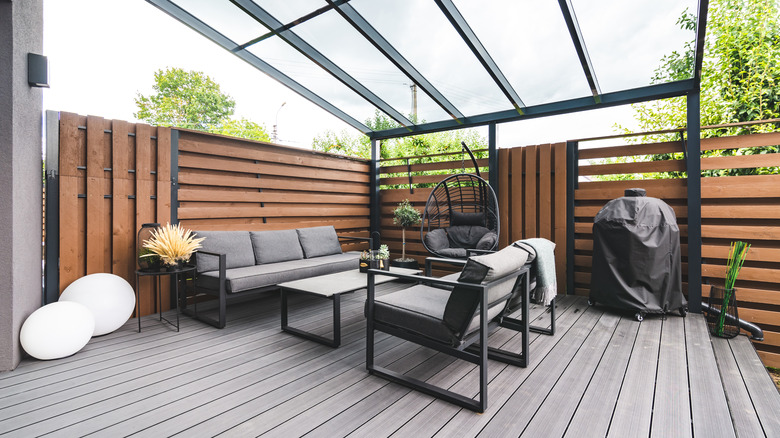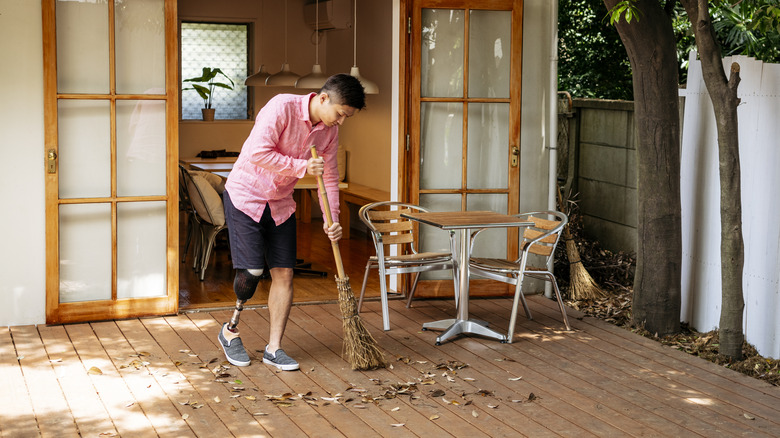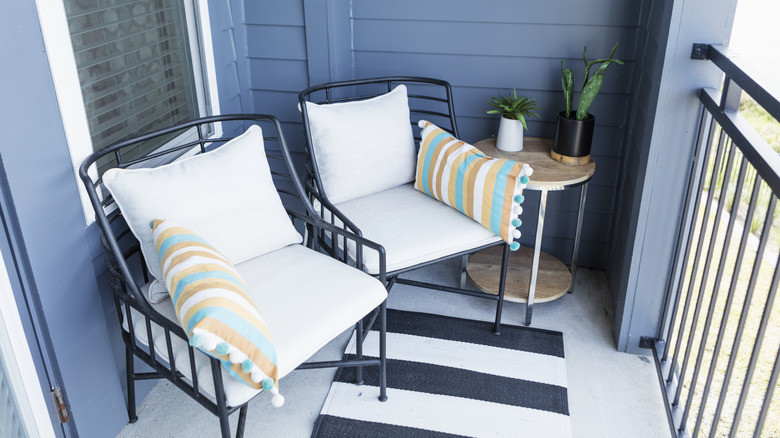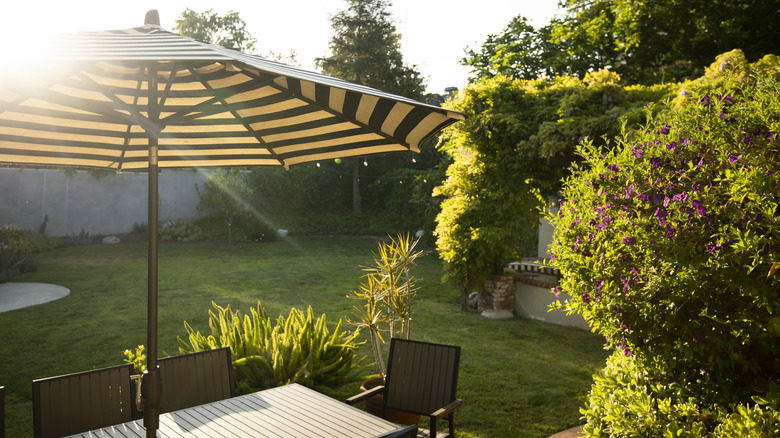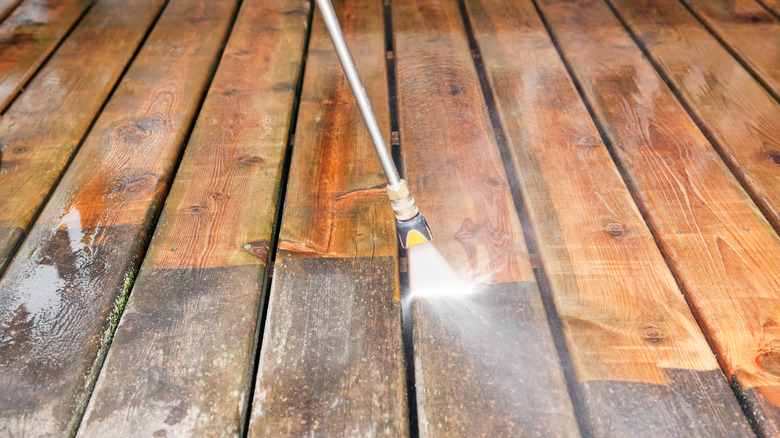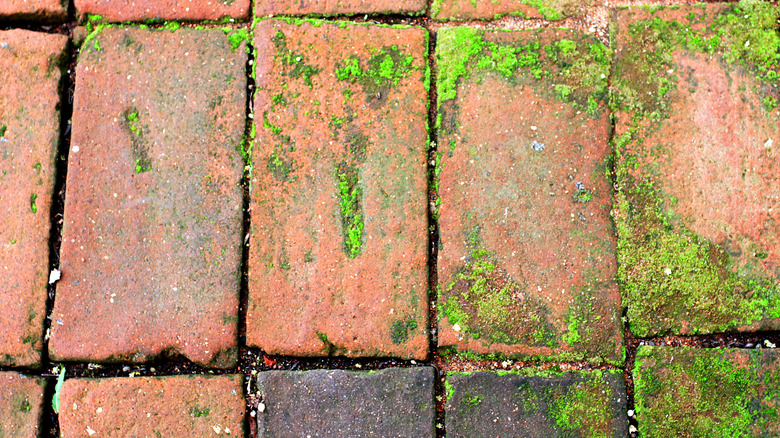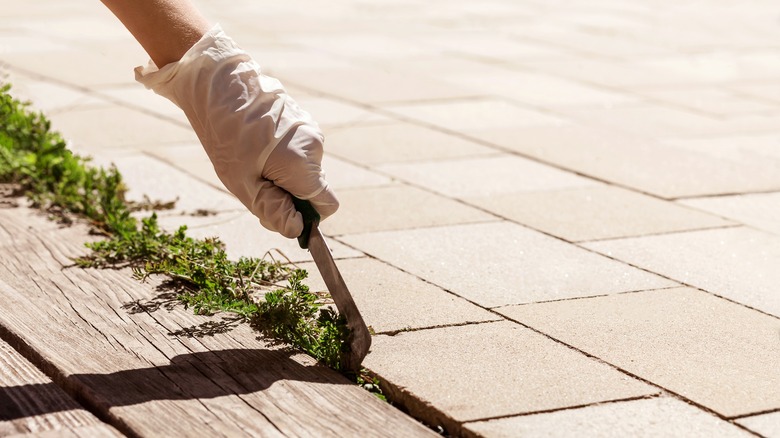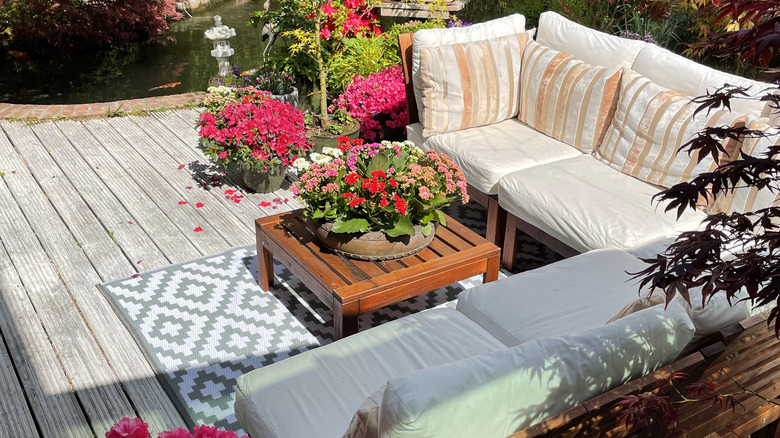8 Tips To Clean Your Patio Like A Pro
We may receive a commission on purchases made from links.
Having a well-maintained and clean patio is not only visually appealing but also essential for various reasons. A properly kept patio creates an inviting and enjoyable oasis for relaxation, entertaining guests, or spending quality time with family. It serves as an extension of your living area, offering a seamless transition between your indoor and outdoor spaces. Regular upkeep and cleanliness of your patio can significantly prolong its lifespan, saving you time and money on repairs or replacements. But the importance of maintaining it goes beyond aesthetics.
Accumulated dirt, debris, and grime can damage the surface over time. Leaves, twigs, and other organic matter can decompose, leading to staining and discoloration. Mold, mildew, and algae can thrive in moist areas, causing slippery surfaces and potential safety hazards. Investing time and effort into cleaning it is a worthwhile endeavor, even if it requires a bit more laborious work. Here are some simple, yet effective steps to clean your patio like a pro.
Schedule routine mopping and sweeping
A fantastic place to start on your patio cleaning journey would be to schedule routine mopping and sweeping. This makes a world of difference in your outdoor space's overall cleanliness and appearance. You'll reap numerous benefits by doing this on a regular basis. One of the key advantages of routine mopping and sweeping is the removal of dirt, dust, and debris. These particles settle on surfaces, making them appear dull and dirty. Routine cleaning prevents them from being ground into the patio surface, reducing the chances of stains and discoloration.
The frequency of mopping and sweeping depends on various factors, such as the location of your patio (is it near a tree?), the surrounding environment, and the amount of foot traffic it receives. As a general guideline, it's recommended to sweep it at least once a week, though you can do it more often than that if needed. Mopping can be done less frequently, typically once a month. However, it's important to adjust the timeline based on your specific circumstances and the level of collected dirt and debris. This simple tip also eliminates potential tripping hazards because it clears away loose gravel and twigs, ensuring a safe environment for everyone.
Routinely wipe down furniture and cushions
Nothing is worse than going outside to relax on your patio and being unable to because your furniture has a layer of grime. That's why routinely wiping down your outdoor furniture and cushions is another pro tip that will elevate the state of your outdoor space. Determining how often you should do this will depend on location, weather conditions, and usage. The best practice is to wipe down furniture at least once every two weeks so it's ready for use. That number can rise if you live in a particularly dusty spot or near a busy road. Cushions may require more attention, especially if they're exposed to spills, food crumbs, or outdoor elements.
To do so, you'll need a soft cloth, mild soap, and a bucket of warm water. Do not use abrasive materials or harsh chemicals since they can damage the fabric. Gently brush off any loose dirt or debris, and then wipe down the cushions and frames using soapy water. Wipe it clean with a new wet cloth, and allow the cushions to air dry before placing them back on the furniture.
Wash outdoor fabrics
Washing your outdoor fabrics is crucial in keeping your patio clean and maintaining a professionally done appearance. Outdoor materials, such as cushions, pillows, hammocks, curtains, and umbrella covers are exposed to various elements like dirt, pollen, bird droppings, and spills. Over time, these substances can accumulate, leading to a less-than-desirable look and potentially compromising the longevity of your fabrics. By including regular fabric washing in your patio maintenance routine, you can keep your outdoor space fresh, vibrant, and welcoming.
First, it's best to create a list of outdoor fabrics that require washing. Then check the manufacturer's instructions or labels for any specific cleaning guidelines or restrictions. The steps may vary depending on the material and the extent of dirt or stains. In general, start by removing loose dirt and debris by gently brushing or shaking the fabric. For minor stains or spills, spot clean with a mild detergent and water. For more thorough cleaning, wash it cold on a delicate cycle with mild laundry detergent. Allow the fabric to air dry before reassembling or using it. This effective pro cleaning tip will help eliminate odors and restore a fabric's vibrancy and freshness.
Pressure wash wood or concrete
Over time, outdoor surfaces can accumulate dirt, grime, algae, mold, and even stubborn stains that can mar the appearance of your patio. Pressure washing your wood or concrete surface is a crucial step in maintaining its condition and protecting it from damage. How often you do this will depend on factors like location, climate, and level of foot traffic. Pros recommend pressure washing your patio at least once a year, though if yours is prone to rapid buildup, you may need to do it more frequently. You'll need a pressure washer specifically designed for outdoor surfaces. For wood patios, use a washer with adjustable settings to avoid damaging the wood. For concrete, a higher setting will be necessary to effectively remove stains.
First, move any furniture and attach the pressure washer to a water source. Then move the nozzle in a sweeping motion, working in small sections. You want to keep a consistent distance from the surface, typically around 6 to 12 inches for the best results. Getting too close to the surface can cause excessive pressure to damage the material. Finally, allow the patio to dry before applying sealants or putting furniture back. Doing this regularly removes deep-seated dirt and grime. It also helps to prepare the surface for any subsequent treatments like sealing or staining, allowing for better adhesion and longer-lasting results. When you eliminate the contaminants, you prevent them from causing discoloration, decay, or potential slip hazards.
Remove mold or algae
Removing mold and algae from your patio is not just a matter of aesthetics; it's a critical step in maintaining a clean and safe outdoor space. Mold and algae thrive in damp, shaded areas, especially in regions with high humidity or frequent rainfall. These organisms can quickly take hold on various surfaces, including concrete, wood, or stone. If left untreated, mold can trigger allergic reactions and respiratory issues in individuals sensitive to its spores. Algae makes surfaces slippery, increasing the risk of slips and falls. Spotting mold and algae problems on your patio can be relatively straightforward. Look out for dark, discolored patches on the surface, particularly in shaded or damp areas. Mold often appears fuzzy or powdery, while algae may manifest as green, brown, or blackish growth.
To clean small patches, you can start by scrubbing the affected areas with a mixture of water and mild detergent. Use a stiff brush or a sponge to thoroughly scrub the surface and remove any visible growth. Rinse the area with clean water afterward. For stubborn or extensive growth, combine 1 cup of white vinegar, 1 cup of warm water, 1 tablespoon of baking soda, and a few drops of dish soap into a spray bottle. Let the solution sit on the area for 15 to 20 minutes. Then, scrub it with a brush or sponge, rinsing thoroughly with clean water. You may want to wear protective gear such as gloves and a mask for safety.
Remove pesky weeds
If not maintained, weeds can quickly take root in the cracks and crevices of your patio, compromising its structural integrity. Proper removal of weeds is essential to prevent their regrowth and spread. Spotting weeds on your patio is relatively easy, as they tend to emerge between pavers, in gaps, or along the edges. They can vary in appearance, from small and inconspicuous to larger plants that compete for space with your desired vegetation.
Start by pulling out the weeds manually, making sure to remove the entire plant, including the roots. A hand tool such as a weeding knife or a narrow trowel can assist in getting a good grip on the roots. Take care to avoid damaging the patio surface while extracting them. For more stubborn or deeply rooted weeds, consider using a weed killer formulated for patios and hardscapes like Ortho GroundClear Super Weed & Grass Killer. Mix the weed killer concentrate with water and apply it directly onto the weeds. This product comes with a handy trigger for more direct application. Allow the liquid to take effect, and regularly monitor and remove any new weed growth. A weed-free patio improves your outdoor space's overall appearance and curb appeal. Weeds can create a neglected and unkempt look, so stay vigilant in spotting and removing them when they appear.
Wash windows
If your patio connects to your house, washing your windows will enhance your space's overall look and feel. The natural light that enters through clean windows can brighten up your patio and make it feel more welcoming and spacious. The frequency of window washing depends on various factors like the climate, proximity to trees or busy roads, and the amount of dirt and debris that accumulates. A good rule of thumb is to wash them at least twice a year, ideally in the spring and fall. But if you notice more buildup or dirt or if you live in an area with a high pollen count, you'll need to wash them more often.
Clean, streak-free windows allow for unobstructed views, creating a seamless connection between your patio and the interior of your home. Start by removing any loose dirt or dust using a soft brush or microfiber cloth. Then, prepare a cleaning solution of either warm water mixed with a few drops of mild window cleaner, or a mixture of 1 part vinegar to 2 parts water. Apply the solution to the windows using a sponge or a window cleaning tool and scrub gently. Rinse thoroughly with clean water and use a squeegee or lint-free cloth to remove any excess moisture and prevent streaks. Doing this also provides an opportunity to inspect the window frames, screens, and seals for any signs of damage, which keeps you updated on any issues before they worsen.
Deep clean outdoor rugs
Deep cleaning your outdoor rugs is a fantastic way to enhance your patio's overall look and feel. They're exposed to various elements like dirt, debris, and stains that collect over time. This dulls their appearance and diminishes their functionality. Schedule this process at least twice a year, though you may need to do it more if you notice heavy soiling or visible stains. A few things you can do to keep yourself from deep cleaning them too often is to regularly sweep or brush off loose dirt to prevent them from settling into the rug's fibers. You'll also want to address any spills or stains as soon as they happen. To protect it from dust or grime, consider putting a tarp over the area each evening or when not in use.
To deep clean your rugs, start by shaking or vacuuming them. Next, prepare a cleaning solution by mixing 1 cup of water with a mild detergent like WoolLite. Using a soft-bristled brush, apply the solution and gently scrub in a circular motion. Rinse thoroughly with clean water, getting rid of all traces of the detergent. If you have a power washer, consider hosing it down using the gentlest setting. Make sure to remove as much water as possible to facilitate quicker drying by hanging it over a railing or clothing line. During periods of heavy rain, consider rolling up and storing your rugs to protect them from excessive moisture and mold growth. If storing them is not an option, ensure proper drainage and ventilation by placing them on elevated surfaces such as a porch overhang, pergola, clothesline, or fence. You can also use rug pads for better air circulation.
